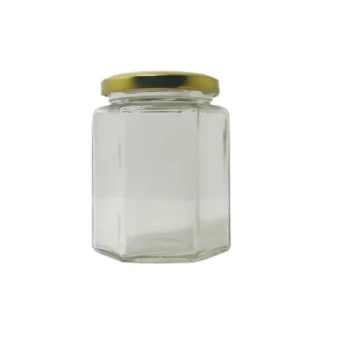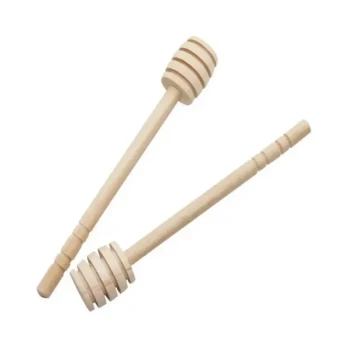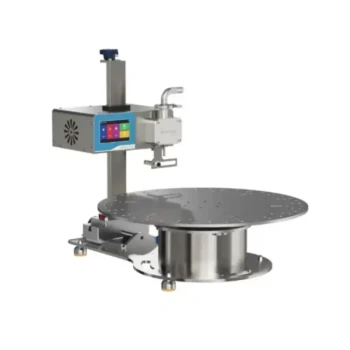When stored correctly, raw honey does not expire. Archaeologists have discovered pots of honey in ancient Egyptian tombs that are thousands of years old and still perfectly edible. For all practical purposes, honey stored in a sealed container can remain stable and safe to eat for decades, and even centuries.
Honey's remarkable longevity is not an accident; it's a direct result of its unique chemical properties. Its extremely low water content and natural acidity create an inhospitable environment where bacteria and other spoilage microorganisms cannot survive.
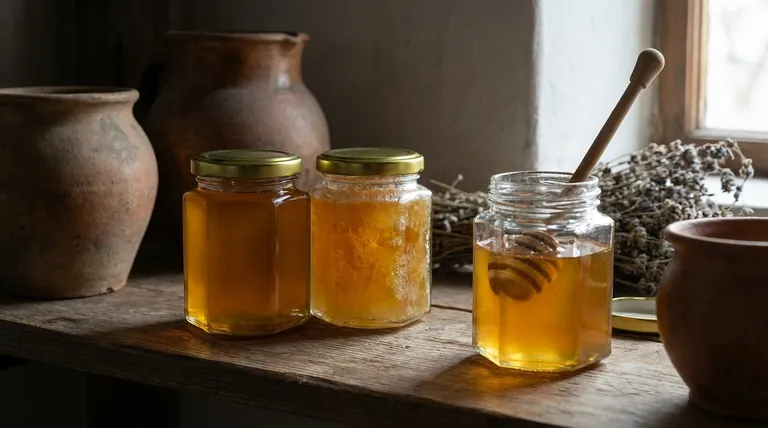
The Science Behind Honey's Stability
The "indefinite" shelf life of honey is a function of three key factors working in concert. Understanding these principles explains why it is one of the most resilient natural foods in the world.
A Dehydrated Environment
Honey is a supersaturated sugar solution with very low water activity. It typically contains only about 17% water, which is far too low to support the growth of yeast or bacteria. These microbes are effectively dehydrated and killed when they come into contact with honey.
A Highly Acidic Nature
Honey is naturally acidic, with a pH level between 3.5 and 4.5. This acidity is due to the presence of various acids, primarily gluconic acid. This acidic environment inhibits the growth of nearly all microorganisms that would otherwise cause spoilage.
The Bee's Contribution: Hydrogen Peroxide
Bees introduce an enzyme called glucose oxidase into the nectar as they produce honey. When honey is exposed to moisture and oxygen, this enzyme works to produce small, consistent amounts of hydrogen peroxide, a compound well-known for its antimicrobial properties.
Understanding the Changes in Your Honey
While honey doesn't spoil, its physical characteristics can change over time. These changes are natural and do not indicate that the honey has gone bad.
The Truth About Crystallization
The most common change is crystallization. This is a natural process where the glucose in the honey separates from the water, forming sugar crystals. This is not a sign of spoilage; it simply means the honey is pure.
To reverse crystallization, gently place the jar in a bowl of warm (not boiling) water and stir until the crystals dissolve. Avoid microwaving, as excessive heat can destroy beneficial enzymes and alter the flavor.
Darkening and Flavor Alteration
Over very long periods, honey may darken in color and its flavor profile may become more robust or slightly different. This is a normal aging process caused by slow chemical changes and is not a sign of spoilage.
The Critical Factor: Proper Storage
Honey's "immortality" is entirely dependent on preventing one key contaminant: water. Incorrect storage can introduce moisture and compromise its stability.
The Only Real Threat is Added Water
If water is added to honey, its water content can rise above the threshold (around 25%) that allows dormant yeasts to become active. This can lead to fermentation, which is the only way honey truly "spoils."
How to Identify Spoiled Honey
Spoiled, fermented honey will have a sour or alcoholic smell and may appear foamy or bubbly. If you see visible mold or notice a fermented odor, the honey has been contaminated and should be discarded.
The Ideal Storage Conditions
The best way to store honey is in its original container or another airtight glass jar. Keep it in a cool, dry place like a pantry, away from direct sunlight and strong heat sources. Do not store honey in the refrigerator, as the cold temperatures will accelerate the natural crystallization process.
A Practical Guide to Your Honey Jar
Follow these simple rules to ensure your honey remains perfect for as long as you need it.
- If your primary focus is long-term preservation: Keep the honey in a tightly sealed glass jar and store it in a cool, dark pantry.
- If your honey has crystallized: Recognize this as a sign of purity and gently warm the jar in warm water to return it to its liquid state.
- If you suspect contamination: Discard any honey that smells sour or fermented, as this indicates water has been introduced and spoilage has begun.
Ultimately, your honey is a remarkably resilient food, and protecting it from moisture is all that's required to preserve it indefinitely.
Summary Table:
| Factor | Role in Honey's Longevity |
|---|---|
| Low Water Activity | Creates a dehydrated environment that prevents microbial growth. |
| Natural Acidity (pH 3.5-4.5) | Inhibits the growth of spoilage microorganisms. |
| Hydrogen Peroxide | An enzyme from bees provides ongoing antimicrobial protection. |
| Proper Sealed Storage | Prevents moisture, the only real threat to honey's stability. |
For commercial apiaries and beekeeping equipment distributors, proper storage is key to preserving honey quality and protecting your investment. HONESTBEE supplies durable, airtight containers and essential beekeeping equipment designed for large-scale operations. Ensure your product remains stable and market-ready for years to come. Contact our wholesale team today to discuss your supply needs and optimize your honey preservation process.
Visual Guide
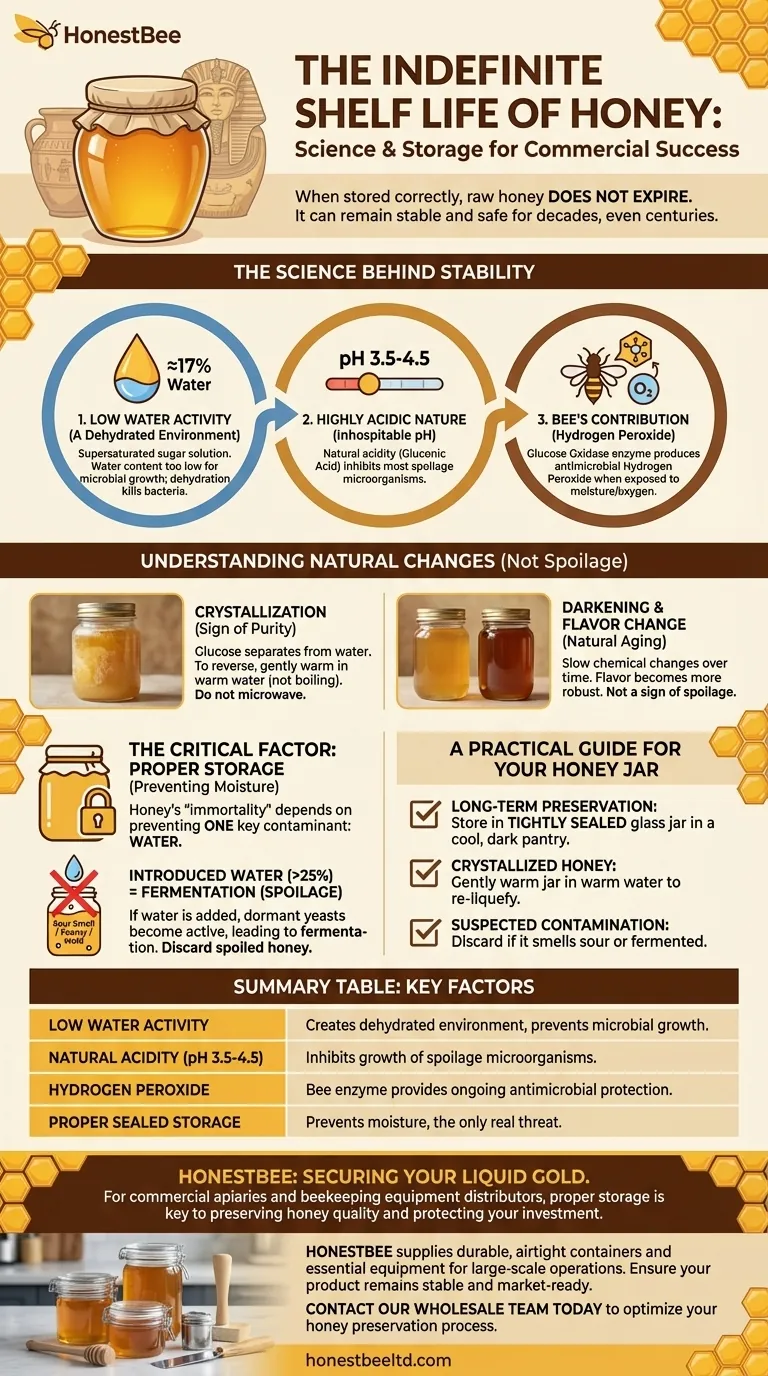
Related Products
- Hexagonal Glass Honey Jars with Metal Lug Caps Elegant Versatile Packaging
- Classic Drum Shaped Glass Honey Jar with Airtight Lid
- Inverted Squeezable Honey Jar with No Drip Flip Top Cap for Easy Pouring
- Plastic Honey Gate Spout with Wing Nut for Beekeeping Honey Bucket
- High Quality Honey Dehumidifier Dryer Thickening Machine for Beekeeping
People Also Ask
- What is the term for honey can absorb moisture from the air? Understanding Hygroscopy
- What is the best way to jar honey? Preserve Quality with the Right Container
- What are the common types of honey packaging? A Guide to Glass, Plastic, Pouches & Tins
- How should honey be stored and packaged? Preserve Flavor & Quality with Proper Containers
- How many jars of honey do you get from a hive? Unlock Sustainable Harvesting Secrets
